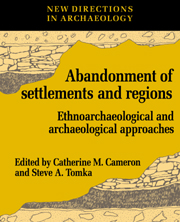Book contents
- Frontmatter
- Contents
- List of figures
- List of tables
- List of contributors
- Acknowledgments
- PART I INTRODUCTION
- PART II REGIONAL ABANDONMENT PROCESSES: ETHNOARCHAEOLOGICAL CASES
- PART III REGIONAL ABANDONMENT PROCESSES: ARCHAEOLOGICAL CASES
- PART IV ABANDONMENT PROCESSES WITHIN SITES: ETHNOARCHAEOLOGICAL CASES
- PART V ABANDONMENT PROCESSES WITHIN SITES: ARCHAEOLOGICAL CASES
- 12 Ceramic analysis as a tool for discovering processes of pueblo abandonment
- 13 Abandonment processes in prehistoric pueblos
- 14 Household abandonment among sedentary Plains societies: behavioral sequences and consequences in the interpretation of the archaeological record
- PART VI CONCLUSIONS
- Index
13 - Abandonment processes in prehistoric pueblos
Published online by Cambridge University Press: 23 May 2010
- Frontmatter
- Contents
- List of figures
- List of tables
- List of contributors
- Acknowledgments
- PART I INTRODUCTION
- PART II REGIONAL ABANDONMENT PROCESSES: ETHNOARCHAEOLOGICAL CASES
- PART III REGIONAL ABANDONMENT PROCESSES: ARCHAEOLOGICAL CASES
- PART IV ABANDONMENT PROCESSES WITHIN SITES: ETHNOARCHAEOLOGICAL CASES
- PART V ABANDONMENT PROCESSES WITHIN SITES: ARCHAEOLOGICAL CASES
- 12 Ceramic analysis as a tool for discovering processes of pueblo abandonment
- 13 Abandonment processes in prehistoric pueblos
- 14 Household abandonment among sedentary Plains societies: behavioral sequences and consequences in the interpretation of the archaeological record
- PART VI CONCLUSIONS
- Index
Summary
Introduction
This paper presents a discussion of site abandonment processes and applies a simulation approach in a case study of abandonment of a ninth–century pueblo in the American Southwest. The general questions addressed are: (1) To what extent can one use archaeological assemblages to explain both abandonment and preabandonment activities and processes? (2) How can one tell what was removed from or added to the systemic assemblage at the time of abandonment? (3) What can intrasite variability in abandonment assemblages tell us about abandonment processes and behavior?
There is an ongoing and sometimes heated debate in archaeology over what kind of record the archaeological record is, and how we should legitimately use it to learn about the past (Ascher 1961; Binford 1981; Schiffer 1976, 1985). Specifically, there have been many accusations that other archaeologists are misusing the archaeological record by falsely assuming a “Pompeii premise,” the term coined by Ascher to refer to a perception of archaeological deposits as “the remains of a once living community, stopped as it were in time” (Ascher 1961:324). Schiffer (1985) criticized Southwestern archaeologists for failing to evaluate adequately the effects of formation processes in creating floor assemblages. He argued that: “The real Pompeii premise is that archaeologists can treat house–floor assemblages at any site as if they were Pompeii–like systemic inventories” (Schiffer 1985:18). Schiffer advocated one alternative which was to evaluate de facto refuse depletions, which are reductions from the basic systemic artifact inventory.
- Type
- Chapter
- Information
- The Abandonment of Settlements and RegionsEthnoarchaeological and Archaeological Approaches, pp. 165 - 177Publisher: Cambridge University PressPrint publication year: 1993
- 17
- Cited by



